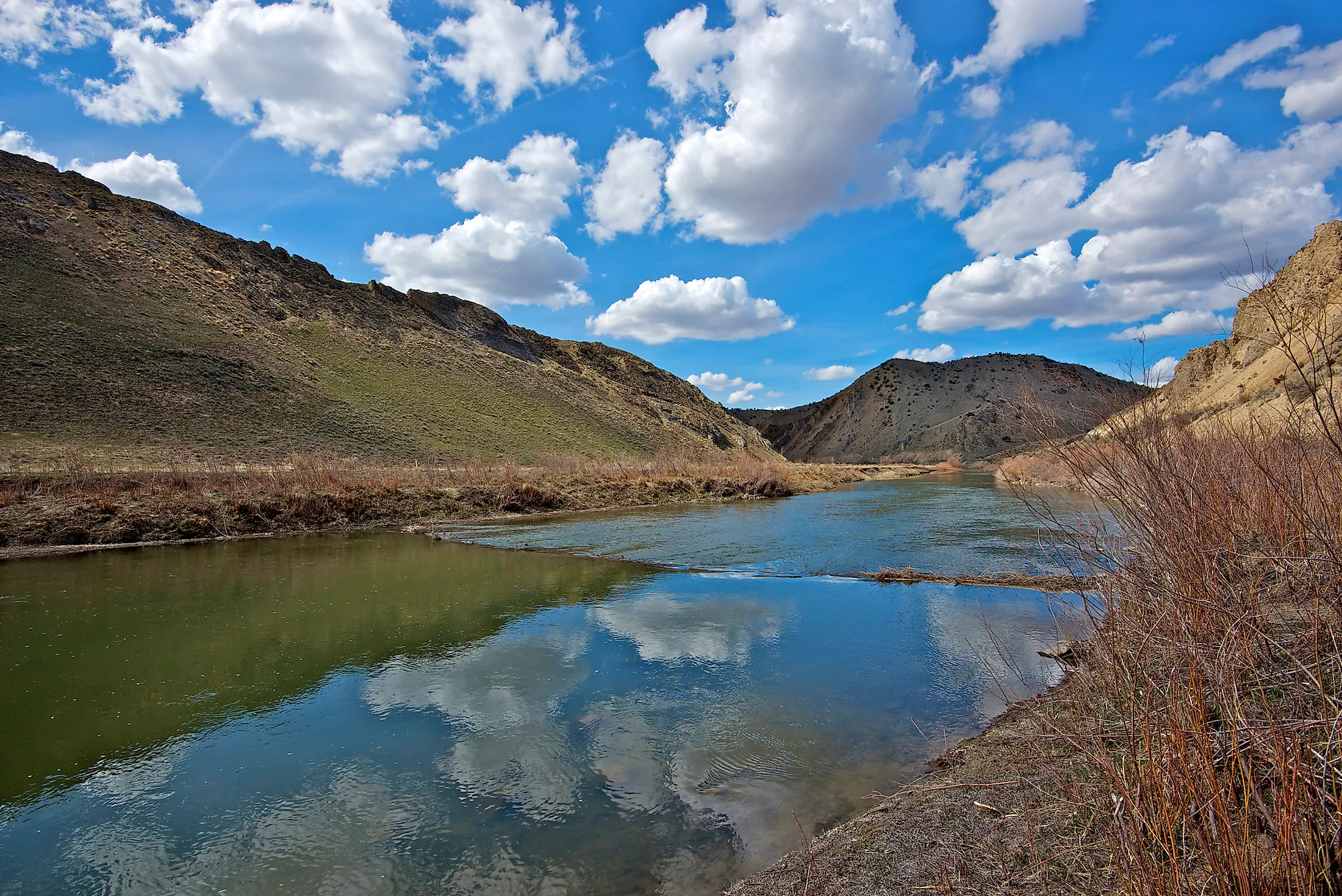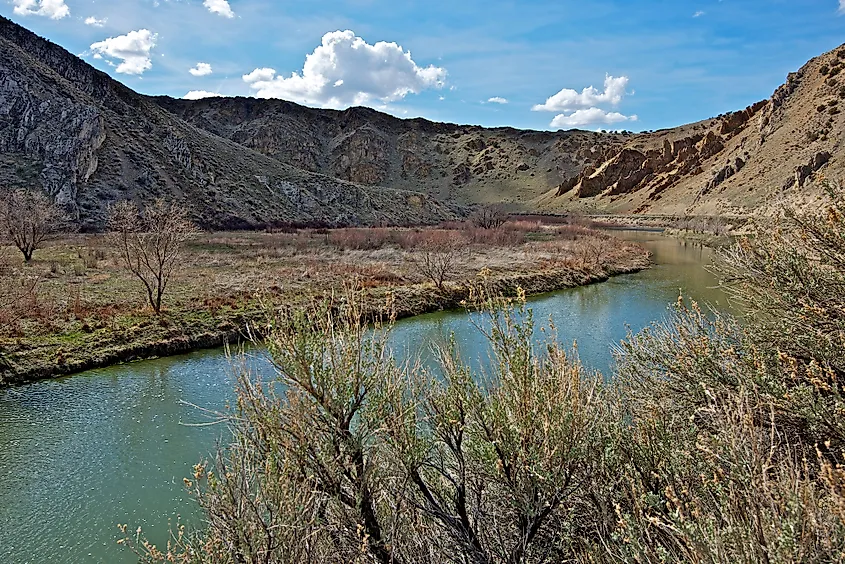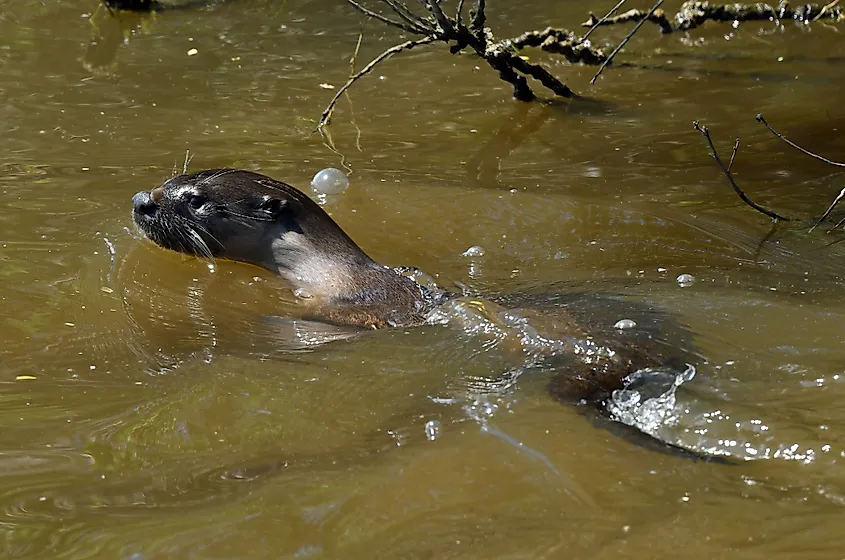
Humboldt River
The Humboldt River Basin is a large river drainage system in north-central Nevada that runs east-to-west from its headwaters in the Jarbidge, Independence, and the Ruby Mountains in Elko County to its termination in the Humboldt Sink in northwest Churchill County, some 225 miles distant. It covers more than 16,000 square miles and is the largest river basin completely inside the state. The river is approximately 330 miles in length and provides water mostly for agricultural uses. It is divided into 34 hydrographic regions. Gold mining is one of the state's greatest businesses, with the bulk of mines located in the Humboldt River Basin on the Carlin Trend.
Course Of The Humboldt River

The river's headwaters are located near the northern end of the East Humboldt Range, just outside the city of Wells. The river runs west-southwest through Elko County, passing through the town of Elko. It runs across northern Eureka County, following the south end of the Tuscarora Mountains and then the north end of the Shoshone Range. It swings northwest at Battle Mountain for about 50 miles, then west at Red House and beyond Golconda and a spur of the Sonoma Range. The river then flows southwest, past Winnemucca and into Pershing County, following the western slope of the Humboldt and West Humboldt ranges. It drains into an intermittent lake in the Humboldt Sink on the boundary of Pershing and Churchill counties, about 20 miles southwest of Lovelock.
The river receives the Humboldt River's North Fork in Elko County, about 15 miles upstream from Elko, and the South Fork about 7 miles downstream. It joins the Reese River at Battle Mountain and receives the Little Humboldt River about 5 miles upstream of Winnemucca. The Rye Patch Dam impounds it in central Pershing County, establishing the Rye Patch Reservoir. The river's flow is very unpredictable, typically decreasing in volume downstream to the west, due in part to the withdrawal of water from the river for agriculture.
History
When European settlers arrived, the Paiute and Shoshone lived in a sparsely populated area along the river in northern Nevada. It was one of North America's last unexplored locations, garnering little attention until the advent of American fur trappers in the mid-nineteenth century.
The river was first seen on November 9, 1828, by Peter Skene Ogden on his fifth journey to the Snake Country. Odgen followed the Little Humboldt River southeast until it met the main river in Winnemucca. Ogden investigated the river for many hundred kilometers, constructing a track along it and creating the region's earliest known map. He named the river "Unknown River" at first, then "Paul's River" after one of his trappers who died during the voyage. He eventually renamed it "Swampy River," then "Mary's River," after the Native American wife of one of his trappers.
The Bonneville-Walker fur team investigated the river in 1833 and named it "Barren River." By the early 1840s, immigrants heading west to California were using the river path. It was explored by John C. Frémont in 1848, who created a detailed map of the area and gave the river its current name. The river became the path of the California Trail the next year, in 1849, the principal land route for migrants to the California gold fields. The river was used as part of the Central Pacific leg of the transcontinental railroad's route in 1869.
In the twentieth century, the river valley became the route for US Highway 40, which was subsequently supplanted by Interstate 80. Today, the majority of northern Nevada's population resides along the river's valley.
Wildlife In And Around The Humboldt River

California bighorn sheep, mule deer, Lahontan cutthroat trout, pronghorn antelope, sage grouse, quail, and raptors are among the many animal species found in the Humboldt River. Here, wild horses wander. Large numbers of cliff-nesting prairie falcons and golden eagles are supported by the steep rock formations and suitable riparian environments. The Little Humboldt River, as well as Snowstorm, Winters, and First creeks, provide a home for native Lahontan cutthroat trout and contribute to thriving fisheries that are believed to have 400 trout per mile of stream.
Astragalus iodanthus is a flowering plant of the Fabaceae family, sometimes known as Humboldt River milkvetch. It is indigenous to the western United States, including California, Idaho, Nevada, Oregon, and Utah. Other plant species found in the river include Aspen, Cheatgrass, Shadscale, Willows, Snowberry, and many others.
Significant Developments
The Humboldt Project is located on the Humboldt River in northeastern Nevada. Rye Patch Dam and Reservoir is located about 22 miles upstream from Lovelock, the county seat of Pershing County, on the Humboldt River. The dam holds river flows until they can be diverted to irrigated regions.
The project areas are located in Lovelock Valley, on the river's lower flood levels, and cover roughly 45,000 acres. Since the 1860s, the Lovelock Valley has served as a gateway for gold and silver prospectors. Farming flourishes, but it is a culture distinct from the passage of miners, ranchers, and tourists through the region. Because the average annual project rainfall is 5.76 inches, every drop of Humboldt is precious.
Threats To The Humboldt River Ecosystem
Continued groundwater withdrawals within the Humboldt River Basin are most certainly contributing to the Humboldt River's streamflow decrease. The timing and severity of the impacts of groundwater withdrawals on Humboldt River streamflow are not well known. Although the Humboldt River Basin's primary use of groundwater is agriculture, a significant amount of groundwater has been extracted from consolidated rock units and basin-fill as part of mining operations in the middle Humboldt River basin. The impact of mine dewatering on streamflow depletion is now regarded to be rather minor, owing to the fact that much of the water was or is still being returned to the river or unconsolidated deposits near the river. Many Humboldt River water rights holders, on the other hand, believe that mine dewatering contributes considerably to streamflow depletion.
Humboldt River, having exceptional scenic, economic, and wildlife values, should be conserved in its free-flowing nature. It is a valuable resource and recreational blessing that must be protected and retained.











